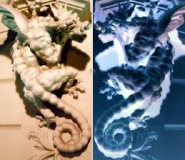Speaker
Eduardo Cortina
Description
The K+ to pi+ nu nubar decay is a flavor changing neutral currentprocess
which proceed through box and purely electroweak penguin diagrams. It is
very clean theoretically: short distance dynamics dominates, c-quarks
contributions have been evaluated to NNLO order at 5%, and the hadronic
matrix elements can be parameterized in terms of the K+ to pi0 e+ nubar
branching ratio that is well known experimentally.
For these reasons K+ to pi+ nu nubar, together with KL to pi0 nu nubar,
is extremely sensitive to new physics contributions.
Moreover, it allows a precise measurement of the CKM parameter V_td,
independent from B oscillation measurements.
The computed branching ratio is (8.0 +- 1.1) 10^(-11).
The existing measurement, based on 3 events from E787/949 experiments
at BNL, is (1.47 +-1.30 +-0.89) 10^(-10), compatible with the
SM within errors. A 10% accuracy measurement is required to provide
a significative test of new physics scenarios.
This is the goal of the proposed NA62 experiment at the CERN SPS, that
aims to collect about 80 events in two years of data taking, keeping
background contamination lower than 10%.
The experiment will be based on the NA48 apparatus and will use the
same CERN-SPS beam line which produced the kaon beam for the NA48
experiment. The experiment is being designed to reach 10^(-12) sensitivity per
event, exploiting a decay in flight technique which allows to reach a 10%
signal acceptance. The detector requires a sophisticated technology for which an intense
R&D program has started. The flux of K+ will be about 100 times higher than for NA48, opening
many other physics opportunities. The status of the project, the R&D program and the perspectives of the experiment will be discussed.
Author
Eduardo Cortina
